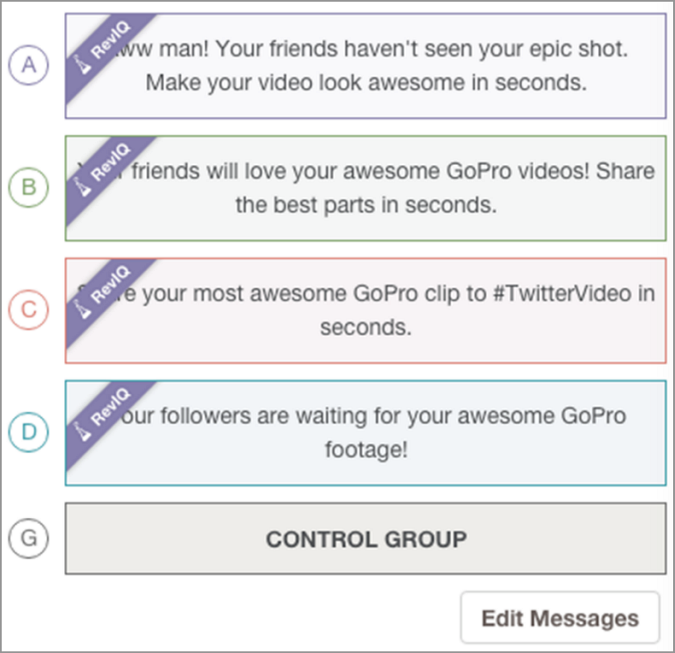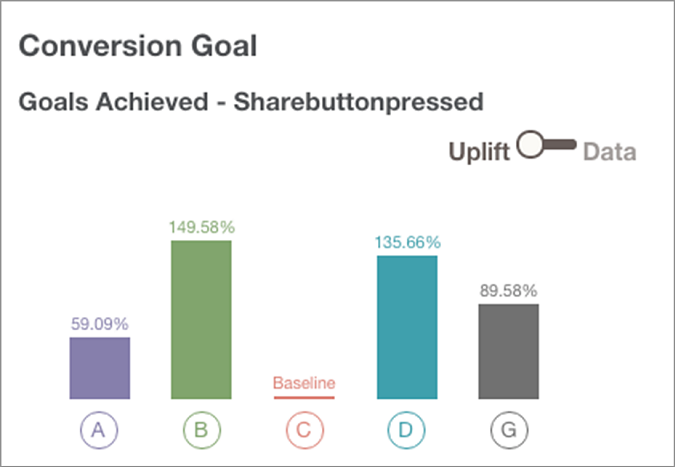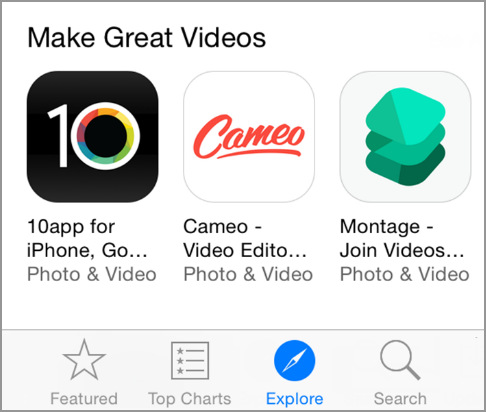by
Courtney Eckerle, Manager of Editorial Content
THE CUSTOMER
In 2014 BrightSky Labs was founded with the objective of making it easy for people to express their passions through video with 10app, a video-editing app for iOS and Android. Since then, usage of video has exploded, with Facebook having passed 5 billion video views a day and Twitter adding a native embedding of video, on top of Vine coming onto the social media scene.
"So much advertising money, of course, has shifted from text and still images toward video. [Snapchat is] going public. Video is so obviously mainstream here at the end of 2015 that it's almost quaint to look back a whole year ago and talk about how a lot of the stuff that we theorized [was somewhat] controversial," Ian McCarthy, Co-Founder, Chief Operating Officer and Head of Product, 10app, said.
Now just shy of half a million users, 10app is used heavily on the weekend, he added, and it is during that optimal time that the marketing team has to engage users through incremental testing. The core of those users own GoPros and are in their 30s and 40s.
CHALLENGE
When you're reaching accommodation of an early adopter audience and a mainstream audience, McCarthy said, it is extremely important to be able to test multiple messages simultaneously, and also segment the targeted audience based on user behavior data.
"Because we were focused on making it easy to express passions through video … We looked around the space and we said, 'Who has the biggest pain point in terms of sharing video?' We looked at the GoPro numbers and we talked to a whole bunch of people who had GoPros like we did," he said.
According to McCarthy, the GoPro has a new category of wearable cameras that are Wi-Fi enabled, "so it has a Web server on the camera, makes it easy to transfer without any wires, the video from your camera to your phone."
Because of that kind of instantaneous connection, it is "super important to reach the user at the right time and the right time of the week and the right time of the season in order to get them to take the action they want," he said.
As a video editing app focused on wearables like the GoPro, the drone and "frankly even your smartphone, the number one KPI that matters to our business is getting you to share. The more liquidity of video flowing through the system, the more things we can do with it and give you more value out of it," McCarthy said.
Users wouldn't be happy, he added, to get a push notification from 10app at 1:00 in the morning asking you to share a video on a Friday or Saturday night, because "you've been out with your friends and you're calling it a night and then all of a sudden you're getting this push from me saying, 'Hey, share the adventure of your weekend.' You would probably uninstall my app."
CAMPAIGN
According to McCarthy, 10app began to focus on GoPro because it is a public filing, and every quarterly filing since then shows that "in any given week, at most 2% of the owners of GoPros shoot video. So, we said, 'Okay, that's great. Let's go solve that problem for them.'"
When 10app launched back in September of 2014, "our whole focus was make it easy for the GoPro user to share videos from their phone by using some big data magic on the phone to recommend the best part to you so you could quickly grab it, adjust it if you want — add a filter, add a song, add a title card — and share it wherever you want," he said.
This same challenge existed when targeting the leading drone maker, DJI Drone.
"Unlike with your phone, you tend to shoot a lot of video, only some of which is interesting to you, let alone anyone else. So you use the magic in the application to recommend the parts that will leave you in control of expressing yourself," he said.
With customer objectives in place, and once "we got really good traction with the early adopter crowd … we started bridging to the mainstream, sharing just from the smartphones," McCarthy said.
Building that bridge to mainstream users required becoming a featured app in the Apple App Store, and eventually securing a consistently high ranking spot in the store. 10app did that through collecting data based on in-app behaviors, and engaging with users in a more personalized way.
That brought in a whole new audience of people who didn't necessarily come for the GoPro or drone capabilities.
"They just saw, 'Oh, Apple thinks this is a good app for editing video. Let's try it out.' App discovery is a huge, huge challenge in a very new field … So it was a very different dynamic than SEO," McCarthy said.
Step #1. Use unique messaging to keep users engaged
According to McCarthy, the whole aim with a push notification is to get a user to notice it, click on it and, once they are taken to the correct place in the app, perform the desired action or set of actions.
"For a video editing [app], what I want you to do is grab one of your videos. So I can't even deep link you into a particular video, because how would I know which video is going to be worth your sharing? Instead, what I do is I point you either to the top level of the app or to a deep level of the app with a message that will be triggering enough of, let's say memories of the weekend if I push it to you on a Throwback Thursday or a Flashback Friday," he said.
Another tactic is to latch onto a topical idea, and 10app did this by capitalizing on the "Back to the Future" mania on October 21, referencing 1.21 gigawatts with the symbol, and Doc Brown's "Get in the car, Marty" line.
"It was so different than every other push notification that you were seeing of, 'So and so left some likes on your Instagram photo,' or 'So and so has just joined Pinterest' or 'So and so pinged you on Snapchat,'" he said.
In the app sphere, it is vital to stand out from the noise, McCarthy said. Unique and catchy messaging is a way to do that and keep users engaged.
Step #2. Begin testing messaging
10app's core user group are GoPro users, who are "late 30s, 40-something, but you want to feel like you're this daredevil like you were early 20s," McCarthy said.
"So even though no gamer today uses the word 'pwn' because that's outdated by like a decade, I figured, 'Well, this audience is rearview mirroring a bit. Let's see how they respond,'" he said.
Paying strict attention to message fatigue is vital, he added, because while that "pwn hook" worked well for about three weeks, it fell off even though it initially hit a nerve in this particular audience. With continued testing, however, the 10app team realized it stopped performing well and evolved the messaging.
They began testing other messaging that would act as a call, or greeting to the user, such as addressing them as "Hey, adventurer."
Use emojis to capture user attention
Another way 10app has begun testing attention-grabbing features is through the inclusion of emojis.
This has been fortuitous for 10app, McCarthy said, because the team has introduced the ability to put emojis right into the video on the iOS version of the app, which tends to be slightly ahead of Android because of the larger user base.
"The inclusion of an emoji … the one that did best was this downhill skier or surfer emoji at the beginning of a message. Again, it just stood out. I don't know about you, but most of the push notifications I get on my phone, they don't have emojis. It catches the eye," he said.
Because 10app is such a visually-focused product, using visual elements like emojis aren't an extraneous hook, McCarthy added, but are part of the brand identity.
"It's reinforcing why you got the app, what you like about the app … So it's one of those things that is super tiny, but it reflects all of the things that are right about a very flexible platform and a visually-focused application," he said.
When testing new elements like this, he added, "you need to be absolutely rigorous about isolating the thing you're testing."
10app focused on A through E testing, sending out a range of push notifications with different variations and a control to its audience.
"You've just got to have a tremendous amount of humility with respect to what your audience is going to do and you will be wrong on every campaign. The aim is to find the [element] that's correct," he said.
Step #3. Begin segmenting messaging by behavior
According to McCarthy, 10app sends different messages depending on where people are connecting from.
"I send different messages to people who are connected to GoPro, [and to] people who have used our Apple Watch app for the GoPro versus ones who have never connected to GoPro, who are on the iOS version. I know, therefore, [they] have come in through one of these promotions from Apple. That's a very different user," he said.
Different messages are going to appeal to these individual users, McCarthy added.
"Sometimes you want to give them the sense that the app … is richer than the use case they are going to use it for because that makes them feel excited about what they got, which itself is an interesting learning," he said.
For example, the team can execute a campaign to communicate only with users who click on the "GoPro library" button but haven't used the share button within the last two days. Hitting the GoPro button is a strong indicator that the user owns a GoPro, according to McCarthy, so it is vital to get this type of user to share.
McCarthy added that they might want to send a different notification messages to "a newbie who's just come in in the last 14 days and has only used the app once. You've got somebody who's engaged, which means they've used the app once in the last 14 days and at least twice ever. It could be 100 times ever, but at least twice. You've got some who are dormant. They've used it twice ever at least, but they have not come in the last two weeks."
With the dormant users, there's a chance to re-engage them using a different messaging method, or hitting them at a different time of the week.
"You're not going to really bother most of the dormant people on a Throwback Thursday because they don't really love your app all that much anyway. You want to hit them on like a Saturday morning or a Sunday because they've got a little more time," he said.
Then, he said, there is a category of user he called the "passerby who tried it out." With this person, the team can use data to determine if that user connected a GoPro, shared a video or added music to any videos.
If they haven't, "then that tells you something that you can encourage that user to use that particular thing," he said.
With every aspect of the app experience, the team can collect that data and model a specific message to that user in order to nudge them to the next level.
Utilize your internal audience
Another best practice that McCarthy brought over from his time at LinkedIn and said he follows rigorously is to run messaging past an internal audience.
"Ask everybody on the team what they think the message for the week should be and you run up the flagpole," he said.
Step #4. Keep consistently testing
Depending on what the team is testing, McCarthy said, "I may test the message first on our engaged users who because they're engaged — they tend to respond much more highly to any message from us — versus the passerby."
Dormant or one-time users aren't the best people to refine your messaging around, he added, so segmenting messaging to only engaged users is essential in getting an accurate response. These engaged users can be a signal as to what will appeal to new or dormant users.
"Learn from them first and then take that learning and apply it to some of the needing to be re-engaged users," he said.
As an example, he said, he sent a message to engaged users on Android in English, which saw an engagement rate of around 47%. Seeing that result, he said, "I've learned from the engaged people and I've recycled the best performing messages there with some new ones in targeting dormant users."
Another example of a test that was run was
a classic notification, personalized for and sent to GoPro users.

Click here to see the full version of this creative sample
"That particular message came from my design co-founder Ann Cleveland … Basically any marketer who doesn't ask their design partner, whose job it is by definition from their professional standpoint, walk in the shoes of the users, any time a marketer doesn't ask a designer what wording they would use, they're losing out on an opportunity," McCarthy said.

Click here to see the full version of this creative sample
The results of this test saw version B in the lead, according to the conversion goal of
Share Button pressed.
McCarthy believes this line of messaging is successful because it capitalizes on a positive side of the fear of missing out, or "FOMO" mentality.
"It's not that you've missed out on it. It's that your friends really would love what you do. Why not just fulfill what they're waiting [for]?" he said.
RESULTS
The two highest performing messages, "Awesomize a video for your followers tonight!" and "#BreakTheInternet with an awesomized video, adventurer!" had engagement increases of 163% and 171%, respectively.
10app was also able to leverage high engagement into being featured in the
Apple App Store.

Click here to see the full version of this creative sample
"That kind of stable, repeat level of engagement is an indication that you need to think of that as a part and parcel of how you're doing everything from engaging users to reminding them and educating them about what you can do," McCarthy said.
It's not all about huge increases, he added. As long as you're constantly evolving messaging based on customer behavior and feedback.
"Sometimes you get campaigns that don't necessarily provide a huge clickthrough … but it [is] important because like all message marketing, email, push notifications or otherwise, you're simultaneously inviting the user to take action, but you're also praising them for having had the good taste and discretion to get your app in the first place," he said.
It's important to keep messages interesting and relevant, he said, because anything else will lead people to ignore you.
"People do want to hear from you when you've got value for them. You've just got to talk with them in a way that's actually valuable to them," he concluded.
Creative Samples
- Messaging
- Messaging results
- App store
Sources
10appKahuna Related Resources
MarketingSherpa Summit 2016 — At the Bellagio in Las Vegas, February 22-24
B2C Marketing: Lawn care company saves more than $800,000 in direct mail postage by integrating emailB2C Marketing 2015: Top case studies reveal 7 most effective tactics that drive revenue and engagement












